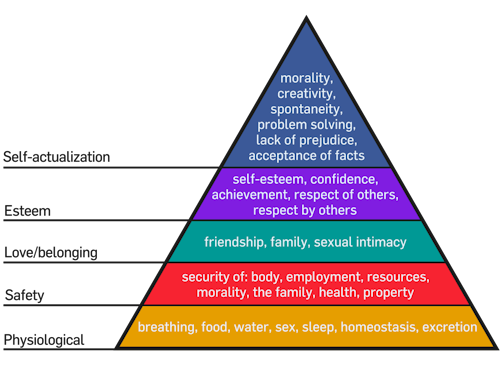Maslow's Hierarchy of Needs
Shows how unmet needs block team growth and collaboration.
"What a man can be, he must be. This need we may call self-actualization." 1

Maslow's Hierarchy of Needs is a psychological theory developed by Abraham Maslow in 1943 to explain human motivation. It is typically represented as a five-tier pyramid, beginning with physiological needs and progressing through safety, love and belonging, esteem, and culminating in self-actualization. In an Agile context, this model provides a powerful lens for understanding team health, motivation, and potential. Agile teams are expected to be self-organizing, adaptive, and continuously learning, none of which are realistic if foundational human needs are being ignored. Agile leaders and coaches who apply this hierarchy can better identify hidden barriers to performance and cultivate a more human-centered environment.
Impact on Teams
When team members' core needs are unmet, their engagement and contribution diminish. Agile performance depends on motivated individuals working in psychologically safe environments.
Maslow's Five Levels of Needs
- Physiological Needs:
- Basic survival needs: food, rest, shelter.
- Agile relevance: Overwork, poor workspace, or chronic exhaustion limit quality and velocity.
- Safety Needs:
- Physical security, job stability, financial safety, psychological protection.
- Agile relevance: Fear of blame or job loss discourages experimentation and honest Retros.
- Love and Belonging:
- Inclusion, friendship, teamwork, sense of connection.
- Agile relevance: Collaboration suffers when people feel isolated or excluded from decision-making.
- Esteem Needs:
- Respect, recognition, status, and self-worth.
- Agile relevance: Clear roles, constructive feedback, and appreciation build confidence and initiative.
- Self-Actualization:
- Purpose, growth, creativity, fulfillment.
- Agile relevance: Empowered teams that align with purpose reach high performance through autonomy and innovation.
Scenario
A Scrum team works under high pressure, with tight deadlines and little job security. The team has no shared space for collaboration, Retrospectives are skipped or superficial, and decisions are made without team input.
- Some developers isolate themselves to avoid scrutiny.
- Others feel burned out or ignored and begin disengaging from planning.
- New ideas or improvements are withheld for fear of failure or criticism.
Here, the team is stuck at the lower tiers of Maslow's pyramid. Until their needs for safety, belonging, and recognition are addressed, coaching techniques and process adjustments will have limited impact.
Ways to Mitigate:
Agile coaches can assess and address needs at each level to promote healthier team dynamics and sustainable growth.
- Stabilize the Foundation:
- Ensure workloads are sustainable and expectations clear.
- Provide ergonomic work environments and adequate compensation.
- Promote Safety:
- Foster psychological safety through no-blame cultures and inclusive facilitation.
- Ensure leaders model vulnerability and support.
- Build Belonging:
- Use team-building and inclusive planning.
- Rotate facilitation and involve everyone in ceremonies.
- Strengthen Esteem:
- Give meaningful recognition regularly.
- Establish clear paths for learning and career growth.
- Enable Self-Actualization:
- Connect tasks to customer impact and purpose.
- Allow autonomy in solving problems and refining practices.
Conclusion:
Maslow's Hierarchy of Needs reminds us that peak team performance is only possible when foundational human needs are respected. Agile coaches and leaders must look beyond tools and techniques to consider what truly motivates people. Creating the right conditions for safety, inclusion, recognition, and growth enables Agile teams to reach their full potential.
Key Takeaways
- Maslow's pyramid highlights human needs that directly impact Agile effectiveness.
- Teams stuck in lower tiers of the hierarchy will struggle with motivation and collaboration.
- Agile environments must first meet basic and psychological needs before expecting high performance.
- Self-actualizing teams require autonomy, trust, and purpose.
- Coaches should use the hierarchy to diagnose dysfunction and guide interventions.
Summary
Maslow's Hierarchy of Needs provides a clear, human-centered framework for understanding Agile team health. By addressing physiological, safety, social, and esteem needs, teams become positioned to self-organize and continuously improve. This approach empowers teams not only to deliver but to thrive.